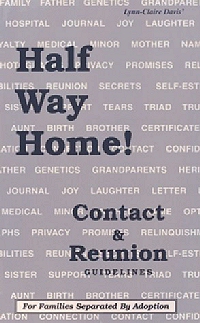
Half Way Home!
by Lynn-Claire Davis
Gabrielle Books, 1995
Reviewed by Barbara Free, M.A.
Perhaps this book should be re-issued, or even updated and republished, because it contains a lot of sound advice and brings up many issues that are just as important now as they were in 1995 when it was published. Although there have been many books about search and reunion, either first-person stories or guidebooks, this one seems in some ways more complete than most. As the author states in the first few pages, “We discover how little society and professionals know about our issues. ... So, in addition to searching, we campaign along the way to educate a blind, incredibly ignorant public. ... We as a group complete our searches in a matter of minutes, days, weeks, months, or years. The longer it takes, the more we grow and learn. We seldom realize searching is merely Volume One in a series.”
She goes on the explore the feelings as well as hopes that the person searching might have, and also the person who is found. She discusses early on the possibility of finding that the person for whom one is searching is already deceased. Although this is more likely when an adoptee is searching for a birth parent, it does also happen when a birth parent is searching for relinquished offspring. In that case, she encourages people to find other birth family, to meet siblings, aunts, uncles, grandparents, whoever might have known the person well. She also addresses the possibility that the adoptee being searched for does not knew of their own adoption, though that is fairly rare these days. She discusses writing a letter versus calling the person, and also having someone else make the initial telephone call. Her ideas about who would and who would not be appropriate persons to make the call are quite insightful, and have rarely been addressed in print.
She even gives an example of a telephone call to ascertain whether an adoptee knows they are adopted, by disguising the call as an opinion poll, but warns that the birth mother should not be the one to make such a call, because she probably cannot sound objective and unemotional. She says both males and females will respond in more depth to a female caller. Then she has some suggestions for what to do if the adoptee seems unaware of their adoption, and states that the birth parents are not responsible for such a lifelong deception.
The author also recommends numerous books for the searcher to read, and some to recommend to the one found, if s/he has not already read them. Again, there are numerous books that have been published since this one, but her recommendations are still very sound, and many of the books are timeless in their insight.
One of her most profound bits of advice is a list of DO NOTS about search, including, “DO NOT enter into a search with an attitude of being ’owed’ for what you have suffered or what a search has cost you. It can get out of hand and pervade your contacts, which can work against you and your goals. There is a difference between your right to know and being owed something.” That advice alone is worth the cost of the book!
The author also shares several persons’ stories at times to illustrate various situations, and she discusses at length the issue of “split loyalties” that many adoptees face, particularly if adoptive parents are not supportive of search and reunion, or the adoptee assumes they would not be supportive. She offers some excellent ideas on how to resolve such dilemmas. Finally, she discusses genetic attraction, which often gets interpreted as sexual attraction, because we have no other societal frame of reference for the yearning to be physically close to the person we’ve found. She stresses the importance of both honesty and courtesy, and the patience to take the time to develop reunion relationships slowly. Just because persons may be biologically related does not mean they instantly understand or agree with each other.
This book ought to be recommended reading for anyone just starting their search. Even if you completed your search years ago, this book is worth reading, both for your own affirmation and for help in continuing relationships, as well as finding the words to describe your situation to others in your life.
That said, it seems a shame it is no longer in print. Existing copies are available from various second-hand dealers via Amazon.com, e.g., so anyone reading this, particularly therapists or those active in adoption support groups, might do well to obtain a copy. For members of O.I., the library copy is available to borrow.
Excerpted from the October 2014 edition of the Operation Identity Newsletter
© 2014 Operation Identity